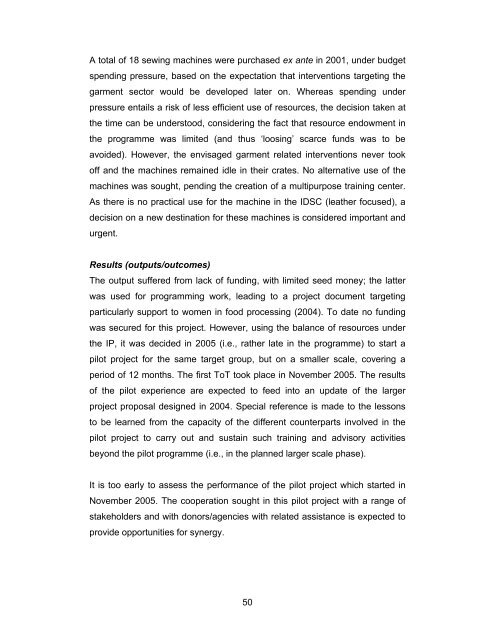Sustainable and Competitive Industrial Development - Unido
Sustainable and Competitive Industrial Development - Unido
Sustainable and Competitive Industrial Development - Unido
You also want an ePaper? Increase the reach of your titles
YUMPU automatically turns print PDFs into web optimized ePapers that Google loves.
A total of 18 sewing machines were purchased ex ante in 2001, under budget<br />
spending pressure, based on the expectation that interventions targeting the<br />
garment sector would be developed later on. Whereas spending under<br />
pressure entails a risk of less efficient use of resources, the decision taken at<br />
the time can be understood, considering the fact that resource endowment in<br />
the programme was limited (<strong>and</strong> thus ‘loosing’ scarce funds was to be<br />
avoided). However, the envisaged garment related interventions never took<br />
off <strong>and</strong> the machines remained idle in their crates. No alternative use of the<br />
machines was sought, pending the creation of a multipurpose training center.<br />
As there is no practical use for the machine in the IDSC (leather focused), a<br />
decision on a new destination for these machines is considered important <strong>and</strong><br />
urgent.<br />
Results (outputs/outcomes)<br />
The output suffered from lack of funding, with limited seed money; the latter<br />
was used for programming work, leading to a project document targeting<br />
particularly support to women in food processing (2004). To date no funding<br />
was secured for this project. However, using the balance of resources under<br />
the IP, it was decided in 2005 (i.e., rather late in the programme) to start a<br />
pilot project for the same target group, but on a smaller scale, covering a<br />
period of 12 months. The first ToT took place in November 2005. The results<br />
of the pilot experience are expected to feed into an update of the larger<br />
project proposal designed in 2004. Special reference is made to the lessons<br />
to be learned from the capacity of the different counterparts involved in the<br />
pilot project to carry out <strong>and</strong> sustain such training <strong>and</strong> advisory activities<br />
beyond the pilot programme (i.e., in the planned larger scale phase).<br />
It is too early to assess the performance of the pilot project which started in<br />
November 2005. The cooperation sought in this pilot project with a range of<br />
stakeholders <strong>and</strong> with donors/agencies with related assistance is expected to<br />
provide opportunities for synergy.<br />
50
















